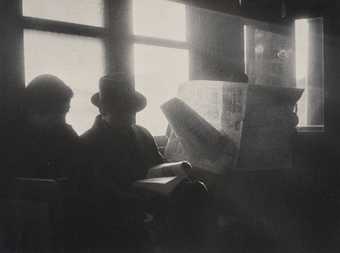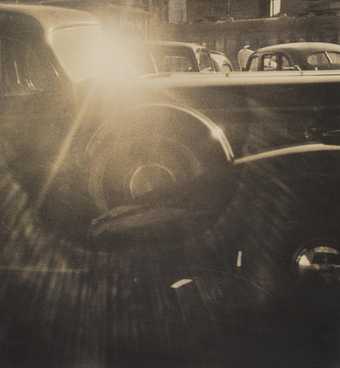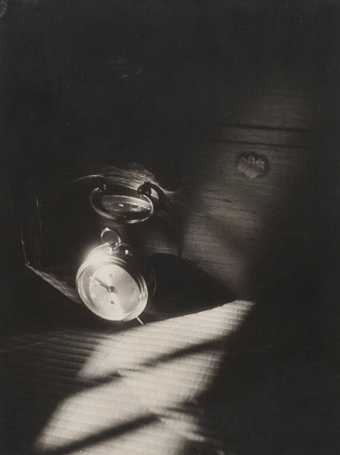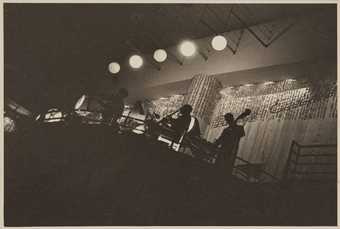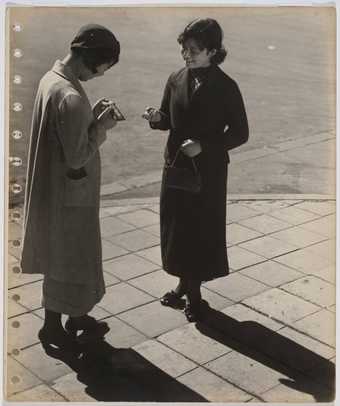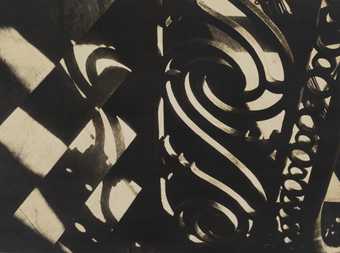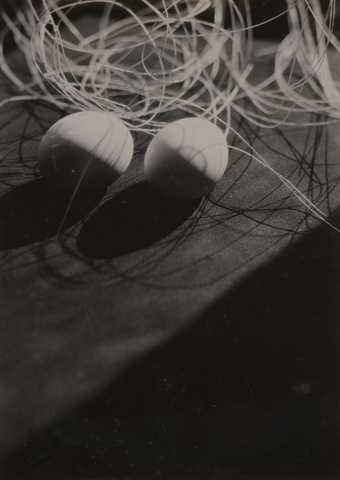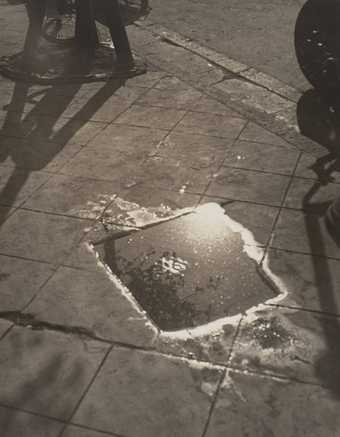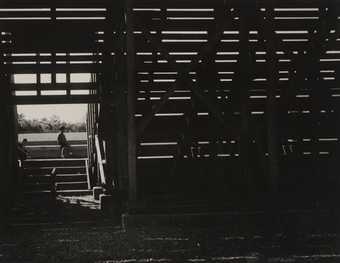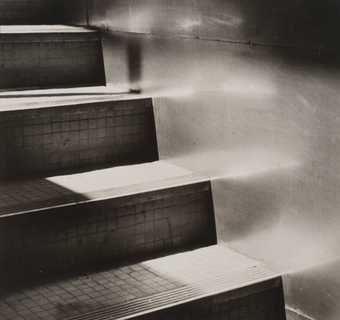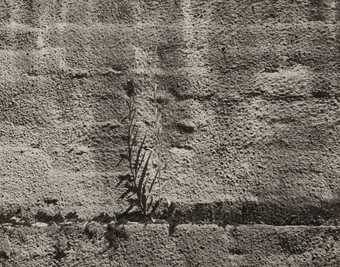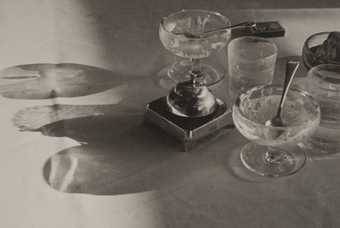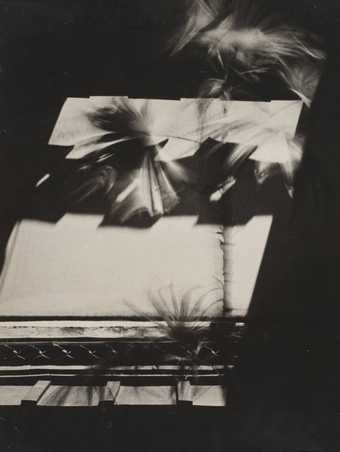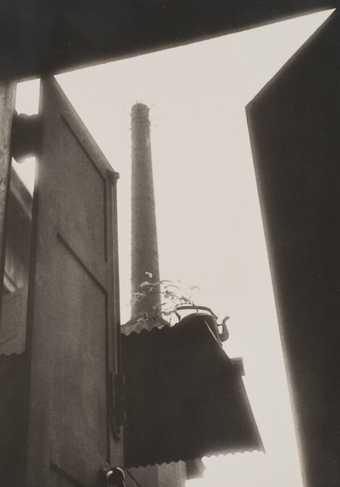
In Tate Liverpool
- Artist
- Shikanosuke Yagaki 1897–1966
- Medium
- Photograph, gelatin silver print on paper
- Dimensions
- Support & image: 271 × 215 mm
- Collection
- Tate
- Acquisition
- Presented by Jacqui Brantjes and Daniel Pittack 2010
- Reference
- P13148
Summary
Untitled (Street lamp and shadow) is a black and white gelatin silver print on paper, set within a window mount and framed. The image has a portrait orientation and shows a crop of a building’s facade taken at an angle from what appears to be street level, looking upwards. The plain concrete building is punctuated by two unadorned rectangular windows and at the top edge of the image the structure’s cornice is visible beneath a slither of sky. The foreground of the photograph is dominated by a metal lamp, affixed by thin arms to the wall of the building. The sun casts the shadow of the lamp onto the concrete surface, revealing the geometry of the lamp’s design and highlighting the contrast between the solidity of the metal and the translucence of the glass bulb.
Untitled (Street lamp and shadow) was taken between 1930 and 1939 by amateur Japanese photographer Shikanosuke Yagaki. Interest in photography surged in Japan in the wake of the Great Kanto earthquake of 1923. At this time, newspapers had become inexpensive and easy to circulate, and the documentary photographs of the disaster contained within the pages of the press increased the status of the photographic medium. As Tokyo was rebuilt, photographers continued to document the emergence of the modern city and the consequences of its refashioning in concrete, glass and steel. This modern Japanese photography movement became known as Shinko Shashin and magazines such as Japan Photographic Annual and Asahi Camera, launched in 1925 and 1926 respectively, provided a platform for the work of its members. Many photographic clubs also emerged at this time, linked by the All Japan Association of Photographic Societies, which enabled exhibitions of its members’ work. Yagaki was an active member of three of these groups throughout the 1930s: the Sanwa Bank Photo Club, the Karashishi-kai Photo Group and the Kyoto Leica Club.
A further consequence of the increased appetite for photography in Japan was that exhibitions of work by European modernist and surrealist photographers were imported and toured the country, including a 1929 Werkbund exhibition of German photographs called Film und Foto which featured the work of artists from the Bauhaus such as Laszlo Maholy-Nagy, Marianne Brandt and T. Lux Feininger. The influence of these European photographers can be observed in the images created by their Japanese counterparts, including those of Yagaki. His photographs, which are also represented in the Tate collection by works such as Untitled (Street) 1930–9 (Tate P13147) and Untitled (Clock) 1930–9 (Tate P13149), employ an unusual vantage point and focus on uncovering the unexpected beauty that can be found in the everyday. Yagaki’s work also embodies the Japanese idea of ‘wabi-sabi’, a philosophy that embraces the transient and the imperfect to capture a fleeting beauty. The convergence of these two influences is revealed in Yagaki’s sensitivity to the play of light, which enabled him to expand the viewer’s perspective by capturing the momentary shadows and reflections of his urban surroundings.
Further reading
Ryuichi Kaneko, Rhapsody of Modern Tokyo, exhibition catalogue, Metropolitan Museum of Photography, Tokyo 1993.
Gennifer Weisenfeld, Visual Cultures of Japanese Imperialism, Durham, North Carolina 2001.
Gennifer Weisenfeld, Imaging Disaster: Tokyo and the Visual Culture of Japan’s Great Earthquake of 1923, Oakland 2012.
Phoebe Roberts
May 2016
Supported by Christie’s.
Does this text contain inaccurate information or language that you feel we should improve or change? We would like to hear from you.
Display caption
Shikanosuke Yagaki was an active member of many of the amateur photography clubs flourishing in Japan in the 1930s, including the Sanwa Bank Photo Club, the Karashishi-kai Photo Group, and the Kyoto Leica Club and his work was widely exhibited. Despite a lack of professional training, Yagaki developed a sophisticated style which combined the influence of European modernism with typical Japanese subjects. His work shows a great understanding of the camera’s potential, playing with movement, perspective, light and shadow.
Gallery label, February 2016
Does this text contain inaccurate information or language that you feel we should improve or change? We would like to hear from you.
Explore
- architecture(30,960)
-
- townscapes / man-made features(21,603)
-
- building - non-specific(3,161)
- streetlight(217)
- formal qualities(12,454)
-
- photographic(4,673)
You might like
-
Shikanosuke Yagaki Untitled (Interior)
1930–9 -
Shikanosuke Yagaki Untitled (Street)
1930–9 -
Shikanosuke Yagaki Untitled (Clock)
1930–9 -
Shikanosuke Yagaki Jazz
1930–9 -
Ryukichi Shibuya Untitled (Advertising photograph, two women on street)
c.1936 -
Shikanosuke Yagaki Banister Detail
1930–9 -
Iwao Yamawaki Untitled (Composition with eggs and string, Bauhaus)
1930–2 -
Shikanosuke Yagaki Untitled (Street)
1930–9 -
Shikanosuke Yagaki Untitled (Interior of wooden building)
1930–9 -
Shikanosuke Yagaki Stairs
1930–9 -
Shikanosuke Yagaki Untitled (Plant and wall)
1930–9 -
Shikanosuke Yagaki Still Life
1930–9 -
Shikanosuke Yagaki Untitled (Composition with light)
1930–9 -
Shikanosuke Yagaki Sudden Wind
1930–9 -
Shikanosuke Yagaki Untitled (Interior with shutters)
1930–9

